Research on the Preferred Illuminance in Office Environments Based on EEG
Abstract
1. Introduction
2. Materials and Methods
2.1. Experimental Environment
2.2. Experimental Conditions
2.3. Selection of Subjects
2.4. Test Contents
2.4.1. Subjective Evaluation
2.4.2. Task Evaluation
2.4.3. Physiological Evaluation
2.5. Experimental Procedure
2.6. Statistical Analysis
3. Results
3.1. Rest Stage
3.1.1. Subjective Evaluation
3.1.2. EEG Analysis of the Rest Stage
3.1.3. The Relationship between the EEG Power and Subjective Evaluation
3.2. Task Stage
3.2.1. Task Performance
3.2.2. EEG Analysis of the Task Stage
4. Discussion
4.1. Neurophysiological Analysis
4.2. Limitations of the Study
5. Conclusions
Author Contributions
Funding
Data Availability Statement
Conflicts of Interest
Abbreviations
| Symbol/Acronym | Definition | Unit |
| AC | Accuracy | % |
| RT | Reaction Time | s |
| PI | Performance Indicator | %/s |
| Power of a band | ||
| Logarithmic power of a band | ||
| EEG total power | ||
| EEG total logarithmic power |
References
- Fisk, W.J.; Singer, B.C.; Chan, W.R. Association of Residential Energy Efficiency Retrofits with Indoor Environmental Quality, Comfort, and Health: A Review of Empirical Data. Build. Environ. 2020, 180, 107067. [Google Scholar] [CrossRef]
- Jia, L.-R.; Li, Q.-Y.; Chen, X.; Lee, C.-C.; Han, J. Indoor Thermal and Ventilation Indicator on University Students’ Overall Comfort. Buildings 2022, 12, 1921. [Google Scholar] [CrossRef]
- Wolkoff, P.; Azuma, K.; Carrer, P. Health, Work Performance, and Risk of Infection in Office-like Environments: The Role of Indoor Temperature, Air Humidity, and Ventilation. Int. J. Hyg. Environ. Health 2021, 233, 113709. [Google Scholar] [CrossRef] [PubMed]
- Yang, G. Vision and Visual Environment (Revised Edition); Tongji UniversityPress: Shanghai, China, 2002. [Google Scholar]
- Burattini, C.; Piccardi, L.; Curcio, G.; Ferlazzo, F.; Giannini, A.M.; Bisegna, F. Cold LED lighting affects visual but not acoustic vigilance. Build. Environ. 2019, 151, 148–155. [Google Scholar] [CrossRef]
- Van Duijnhoven, J.; Aarts, M.; Aries, M.; Rosemann, A.; Kort, H.S.M. Systematic review on the interaction between office light conditions and occupational health: Elucidating gaps and methodological issues. Indoor Built Environ. 2019, 28, 152–174. [Google Scholar] [CrossRef]
- Kim, J.; Dear, R.D. Nonlinear relationships between individual IEQ. factors and overall workspace satisfaction. Build. Environ. 2012, 49, 33–40. [Google Scholar] [CrossRef]
- Wilkins, A.J. Visual Stress; Oxford University Press: New York, NY, USA, 1996. [Google Scholar]
- Winterbottom, M.; Wilkins, A. Lighting and discomfort in the classroom—ScienceDirect. J. Environ. Psychol. 2009, 29, 63–75. [Google Scholar] [CrossRef]
- Boyce, P.R. Review: The Impact of Light in Buildings on Human Health. Indoor Built Environ. 2010, 19, 8–20. [Google Scholar] [CrossRef]
- Sorooshnia, E.; Rashidi, M.; Rahnamayiezekavat, P.; Samali, B. Optimizing Window Configuration Counterbalancing Energy Saving and Indoor Visual Comfort for Sydney Dwellings. Buildings 2022, 12, 1823. [Google Scholar] [CrossRef]
- Zeng, Y.; Sun, H.; Lin, B.; Zhang, Q. Non-visual effects of office light environment: Field evaluation, model comparison, and spectral analysis. Build. Environ. 2021, 197, 107859. [Google Scholar] [CrossRef]
- Kompier, M.E.; Smolders, K.C.H.J.; Kort, Y.A.W.D. Abrupt Light Transitions in Illuminance and Correlated Color Temperature Result in Different Temporal Dynamics and Interindividual Variability for Sensation, Comfort and Alertness. PLoS ONE 2021, 16, e0243259. [Google Scholar] [CrossRef]
- Liu, Y.; Chen, D. An analysis on EEG power spectrum under pressure of girdle. Int. J. Cloth. Sci. Technol. 2015, 27, 495–505. [Google Scholar] [CrossRef]
- MORI, Y.; IKAMI, K.; SUGITA, A.; KIOKA, E. Clothing Comfort of the Material (RAFUMA-Mixed Cotton) of Pajamas from the Point of Biological Reactions. J. Home Econ. Jpn. 2005, 56, 233–240. [Google Scholar]
- ISO 8995-1:2002-05; CIE S 008:2002-05. CIE Central Bureau: Vienna, Austria, 2002.
- Zhang, S. Demonstration of Natural Lighting Design Optimization Using Galapagos and Octopus Taking the Daylighting Opening of Institutional Pension Building as an Example; TianJin University: Tianjin, China, 2017. [Google Scholar]
- Logar, V.; Kristl, Z.; Skrjanc, I. Using a fuzzy black-box model to estimate the indoor illuminance in buildings. Energy Build. 2014, 70, 343–351. [Google Scholar] [CrossRef]
- Wagiman, K.R.; Abdullah, M.N.; Hassan, M.Y.; Radzi, N.H.M. A New Optimal Light Sensor Placement Method of an Indoor Lighting Control System for Improving Energy Performance and Visual Comfort. J. Build. Eng. 2020, 30, 101295. [Google Scholar] [CrossRef]
- UNE-EN 12464-1-2012; Light and lighting—Lighting of workplaces—Part 1: Indoor workplaces. British Standards Institution: London, UK, 2012.
- JISZ9110:2010; Japanese Industrial Standards. Japanese Standards Association: Tokyo, Japan, 2011.
- GB50034-2013; Architectural Lighting Design Standard. China Architecture Industry Press: Beijing, China, 2013.
- Grünberger, J.; Linzmayer, L.; Dietzel, M.; Saletu, B. The effect of biologically-active light on the noo- and thymopsyche and psychophysiological variables in healthy volunteers. Int. J. Psychophysiol. Off. J. Int. Organ. Psychophysiol. 1993, 15, 27. [Google Scholar] [CrossRef]
- Tanabe, S.; Nishihara, N. Productivity and fatigue. Indoor Air 2004, 14 (Suppl. S7), 126. [Google Scholar] [CrossRef]
- Cajochen, C.; Zeitzer, J.; Czeisler, C.; Dijk, D. Dose-response relationship for light intensity and ocular and electroencephalographic correlates of alertness in humans. Behav. Brain Res. 2000, 115, 75–83. [Google Scholar] [CrossRef]
- Xiao, H.; Cai, H.; Li, X. Non-visual effects of indoor light environment on humans: A review. Physiol. Behav. 2020, 228, 113195. [Google Scholar] [CrossRef]
- Jhm, A.; Jin, K.; Shc, C. Effects of lighting CCT and illuminance on visual perception and task performance in immersive virtual environments. Build. Environ. 2021, 209, 108678. [Google Scholar]
- Ru, T.; Smolders, K.C.H.J.; Chen, Q.; Zhou, G.; de Kort, Y.A.W. Diurnal effects of illuminance on performance: Exploring the moderating role of cognitive domain and task difficulty. Light. Res. Technol. 2021, 53, 727–747. [Google Scholar] [CrossRef]
- Lin, C. Effect of noise intensity and illumination intensity on visual performance. Percept. Mot. Ski. 2014, 119, 441–454. [Google Scholar] [CrossRef] [PubMed]
- Ru, T.; de Kort, Y.A.W.; Smolders, K.C.H.J.; Chen, Q.; Zhou, G. Non-image forming effects of illuminance and correlated color temperature of office light on alertness, mood, and performance across cognitive domains. Build. Environ. 2019, 149, 253–263. [Google Scholar] [CrossRef]
- Huiberts, L.M.; Smolders, K.; Kort, Y.D. Shining light on memory: Effects of bright light on working memory performance. Behav. Brain Res. Int. J. 2015, 294, 234–245. [Google Scholar] [CrossRef]
- Teplan, M. Fundamentals of EEG measurement. Meas. Sci. Rev. 2002, 2, 1–11. [Google Scholar]
- Choi, Y.; Kim, M.; Chun, C. Measurement of occupants’ stress based on electroencephalograms (EEG) in twelve combined environments. Build. Environ. 2015, 88, 65–72. [Google Scholar] [CrossRef]
- Shan, X.; Yang, E.H.; Zhou, J.; Victor, W.-C. Chang Human-building interaction under various indoor temperatures through neural-signal electroencephalogram (EEG) methods. Build. Environ. 2018, 129, 46–53. [Google Scholar] [CrossRef]
- Kim, H.; Hong, T.; Kim, J.; Yeom, S. A psychophysiological effect of indoor thermal condition on college students’ learning performance through EEG measurement. Build. Environ. 2020, 184, 107223. [Google Scholar] [CrossRef]
- Li, J.; Wu, W.; Jin, Y.; Bian, W. Research on environmental comfort and cognitive performance based on EEG+VR+LEC evaluation method in underground space. Build. Environ. 2021, 198, 107886. [Google Scholar] [CrossRef]
- Mansi, S.A.; Pigliautile, I.; Pisello, A.L. A novel methodology for human thermal comfort decoding via physiological signals measurement and analysis. Build. Environ. 2022, 222, 109385. [Google Scholar] [CrossRef]
- Wang, H.; Hou, K.; Kong, Z.; Guan, X.; Hu, S.; Lu, M.; Piao, X.; Qian, Y. In-Between Area” Design Method: An Optimization Design Method for Indoor Public Spaces for Elderly Facilities Evaluated by STAI, HRV and EEG. Buildings 2022, 12, 1274. [Google Scholar] [CrossRef]
- Lu, M.; Hu, S.; Mao, Z.; Liang, P.; Xin, S.; Guan, H. Research on Work Efficiency and Light Comfort Based on EEG Evaluation Method. Build. Environ. 2020, 183, 107122. [Google Scholar] [CrossRef]
- Shin, Y.-B.; Woo, S.-H.; Kim, D.-H.; Kim, J.; Kim, J.-J.; Park, J.Y. The effect on emotions and brain activity by the direct/indirect lighting in the residential environment. Neurosci. Lett. Int. Multidiscip. J. Devoted Rapid Publ. Basic Res. Brain Sci. 2015, 584, 28–32. [Google Scholar] [CrossRef]
- Min, B.-K.; Jung, Y.-C.; Kim, E.; Park, J.Y. Bright illumination reduces parietal EEG alpha activity during a sustained attention task. Brain Res. 2013, 1538, 83–92. [Google Scholar] [CrossRef]
- Park, J.Y.; Min, B.-K.; Jung, Y.-C.; Pak, H.; Jeong, Y.-H.; Kim, E. Illumination Influences Working Memory: An Eeg Study. Neurosci. Int. J. Under Editor. Dir. IBRO 2013, 247, 386–394. [Google Scholar] [CrossRef]
- Kuller, R.; Wetterberg, L. Melatonin, cortisol, EEG, ECG and subjective comfort in healthy humans: Impact of two fluorescent lamp types at two light intensities. Light. Res. Technol. 1993, 25, 71–80. [Google Scholar] [CrossRef]
- Kong, Z.; Hou, K.; Wang, Z.; Chen, F.; Li, Y.; Liu, X.; Liu, C. Subjective and Physiological Responses towards Interior Natural Lightscape: Influences of Aperture Design, Window Size and Sky Condition. Buildings 2022, 12, 1612. [Google Scholar] [CrossRef]
- Hsieh, M.-C.; Zhang, Y.-Q.; Dong, R.; Lee, Y.-C.; Ni, C.-y. Use of EEG signals, cortisol secretion, and task performance to evaluate the effects of different lighting environments on concentration level in a sustained attention task. Int. J. Ind. Ergon. 2022, 92, 103371. [Google Scholar] [CrossRef]
- Gollisch, T.; Meister, M. Eye Smarter than Scientists Believed: Neural Computations in Circuits of the Retina. Neuron 2010, 65, 150–164. [Google Scholar] [CrossRef]
- Xiaoling, L.; Zhengqin, Y.; Yuansheng, Y. Visual Neurophysiology; People’s Medical Publishing House: Beijing, China, 2011. [Google Scholar]
- Gazzaniga, M.S.; Ivry, R.B.; Mangun, G.R.; Steven, M.S. Cognitive Neuroscience: The Biology of the Mind; W. W. Norton & Company: New York, NY, USA; Oxford University Press: New York, NY, USA, 1998. [Google Scholar]
- Yang, L.; Ma, R.; Zhang, H.M.; Guan, W.; Jiang, S. Driving Behavior Recognition Using EEG Data from a Simulated Car-Following Experiment. Accid. Anal. Prev. 2018, 116, 30–40. [Google Scholar] [CrossRef]
- Cohen, M.X. Analyzing Neural Time Series Data: Theory and Practice; MIT Press: Cambridge, MA, USA, 2014. [Google Scholar]
- Buzsaki, G. Rhythms of the Brain; Oxford University Press: New York, NY, USA, 2006. [Google Scholar]
- Christoph, S. Human EEG responses to 1–100. Herrmann 2001, 137, 346–353. [Google Scholar] [CrossRef]
- Klimesch, W.; Russegger, H.; Doppelmayr, M.; Pachinger, T. A method for the calculation of induced band power: Implications for the significance of brain oscillations. Electroencephalogr. Clin. Neurophysiol. Evoked Potentials Sect. 1998, 108, 123–130. [Google Scholar] [CrossRef] [PubMed]
- Eroğlu, K.; Kayıkçıoğlu, T.; Osman, O. Effect of Brightness of Visual Stimuli on EEG Signals. Behav. Brain Res. 2020, 382, 112486. [Google Scholar] [CrossRef] [PubMed]
- Subramanian, S.K.; Gaur, G.S.; Narayan, S.K. Low Luminance/Eyes Closed and Monochromatic Stimulations Reduce Variability of Flash Visual Evoked Potential Latency. Ann. Indian Acad. Neurol. 2013, 16, 614–618. [Google Scholar] [CrossRef]
- Münch, M.; Plomp, G.; Thunell, E.; Kawasaki, A.; Scartezzini, J.L.; Herzog, M.H. Different Colors of Light Lead to Different Adaptation and Activation as Determined by High-Density EEG. NeuroImage 2014, 101, 547–554. [Google Scholar] [CrossRef]
- Passynkova, N.R.; Volf, N.V. Seasonal Affective Disorder: Spatial Organization of EEG Power and Coherence in the Depressive State and in Light-Induced and Summer Remission. Psychiatry Res. Neuroimaging 2001, 108, 169–185. [Google Scholar] [CrossRef]
- Hu, S.; Lu, M.; He, M.; Wang, G.; Liang, P.; Tong, L.; Liu, G. Research on the Light Comfort Characterization Method Based on Visual Evoked Potential Energy. Build. Environ. 2021, 197, 107831. [Google Scholar] [CrossRef]
- ASHRAE 55–2017; Thermal Environment Conditions for Human Occupancy, American Society of Heating. Ventilating and Air-Conditioning Engineers: Atlanta, GA, USA, 2017.
- ISO 7726; Ergonomics of the Thermal Environment—Instruments for Measuring Physical Quantities, Measurement of the Mean Radiant Temperature. Danish Standards Association: Charlottenlund, Denmark, 2001.
- ANSI/ASHRAE Standard 55; Thermal Environmental Conditions for Human Occupancy. ASHRAE: Atlanta, GA, USA, 2020.
- Iacomussi, P.; Radis, M.; Rossi, G.; Rossi, L. Visual comfort with LED lighting. Energy Procedia 2015, 78, 729–734. [Google Scholar] [CrossRef]
- Fu, Y.; Wu, Y.; Gao, W.; Hui, R. The Effect of Daylight Illumination in Nursing Buildings on Reading Comfort of Elderly Persons. Buildings 2022, 12, 214. [Google Scholar] [CrossRef]
- Zhang, J.; Lv, K.; Zhang, X.; Ma, M.; Zhang, J. Study of Human Visual Comfort Based on Sudden Vertical Illuminance Changes. Buildings 2022, 12, 1127. [Google Scholar] [CrossRef]
- Scarpina, F.; Tagini, S. The Stroop Color and Word Test. Front. Psychol. 2017, 8, 557. [Google Scholar] [CrossRef]
- Sanei, S.; Chambers, J. EEG Signal Processing; John Wiley & Sons: Hoboken, NJ, USA, 2007. [Google Scholar]
- Zhang, C.; Zheng, C.; Pei, X.; Ouyang, Y. Multiparametric EEG power spectroscopy analysis of physiological mental fatigue. J. Biomed. Eng. 2009, 26, 6. [Google Scholar]
- Baumeister, J.; Barthel, T.; Geiss, K.R.; Weiss, M. Influence of phosphatidylserine on cognitive performance and cortical activity after induced stress. Nutr. Neurosci. 2008, 11, 103–110. [Google Scholar] [CrossRef]
- Gola, M.; Magnuski, M.; Szumska, I.; Wróbel, A. EEG beta band activity is related to attention and attentional deficits in the visual performance of elderly subjects. Int. J. Psychophysiol. Off. J. Int. Organ. Psychophysiol. 2013, 89, 334–341. [Google Scholar] [CrossRef]
- Zhu, M.; Liu, W.; Wargocki, P. Changes in EEG signals during the cognitive activity at varying air temperature and relative humidity. J. Expo. Sci. Environ. Epidemiol. 2020, 30, 285–298. [Google Scholar] [CrossRef]
- Nawrocka, A.; Holewa, K. The Analysis of the Different Frequencies Sound Waves Effect on the EEG Signal. Diffus. Defect Data. Solid State Data Part B Solid State Phenom. 2014, 208, 177–182. [Google Scholar]
- Li, Z.G.; Di, G.Q.; Li, J. Relationship between Electroencephalogram Variation and Subjective Annoyance under Noise Exposure. Appl. Acoust. 2014, 75, 37–42. [Google Scholar] [CrossRef]
- Sun, Y.; Ye, N.; Wang, X.; Xu, X. The Research of EEG Analysis Methods Based on Sounds of Different Frequency. In Proceedings of the 2007 IEEE/ICME International Conference on Complex Medical Engineering, Beijing, China, 23–27 May 2007; pp. 1746–1751. [Google Scholar]
- Shan, X.; Yang, E.H.; Zhou, J.; ChangVictor, W.C. Neural-signal electroencephalogram (EEG) methods to improve human-building interaction under different indoor air quality. Energy Build. 2019, 197, 188–195. [Google Scholar] [CrossRef]
- Zhang, X.; Hu, S.; Song, P.; Ma, H.; Liu, R.; Lu, M.; Liu, G.; Liu, B.; Feature, L.T. and relationship between electroencephalogram power and salivary S-IgE concentration in healthy adults in different indoor temperatures. Build. Environ. 2021, 210, 108688. [Google Scholar] [CrossRef]
- Lievesley, R.; Wozencroft, M.; Ewins, D. The Emotiv EPOC neuroheadset: An inexpensive method of controlling assistive technologies using facial expressions and thoughts? J. Assist. Technol. 2011, 5, 67–82. [Google Scholar] [CrossRef]
- Li, X.; Chen, X.; Yan, Y.; Wei, W.; Wang, Z.J. Classification of EEG Signals Using a Multiple Kernel Learning Support Vector Machine. Sensors 2014, 14, 12784–12802. [Google Scholar] [CrossRef] [PubMed]
- Fauvel, S.; Ward, R.K. An Energy Efficient Compressed Sensing Framework for the Compression of Electroencephalogram Signals. Sensors 2014, 14, 1474–1496. [Google Scholar] [CrossRef] [PubMed]
- Delorme, A.; Makeig, S. EEGLAB: An open source toolbox for analysis of single-trial EEG dynamics including independent component analysis. J. Neurosci. Methods 2004, 134, 9–21. [Google Scholar] [CrossRef] [PubMed]
- Hyvarinen, A.; Oja, E. Independent Component Analysis: Algorithms and Applications. Neural Netw. 2000, 13, 411–430. [Google Scholar] [CrossRef]
- Van, L. Computational Frameworks for the Fast Fourier Transform; SIAM: Philadelphia, PA, USA, 1992. [Google Scholar]
- Murugappan, M.; Murugappan, S. Human emotion recognition through short time electroencephalogram (EEG) signals using fast Fourier transform(FFT). In Proceedings of the 2013 IEEE 9th International Colloquium on Signal Processing and its Applications, Kuala Lumpur, Malaysia, 8–10 March 2013; pp. 289–294. [Google Scholar]
- Zhonghua, G.; Stephen, L.; Yu, S.; Hai, Y. Visual alliesthesia: The gap between comfortable and stimulating illuminance settings. Build. Environ. 2014, 82, 42–49. [Google Scholar] [CrossRef]
- Guan, H.; Hu, S.; Lu, M.; He, M.; Zhang, X.; Liu, G. Analysis of human electroencephalogram features in different indoor environments. Build. Environ. 2020, 186, 107328. [Google Scholar] [CrossRef]
- Han, J.; Chun, C. Differences between EEG during thermal discomfort and thermal displeasure. Build. Environ. 2021, 204, 108220. [Google Scholar] [CrossRef]
- Lan, L.; Lian, Z. Use of Neurobehavioral Tests to Evaluate the Effects of IE on Productivity. First Int. Conf. Build. Energy Environ. 2009, 44, 2208–2217. [Google Scholar]
- Lan, L.; Lian, Z.; Pan, L.; Ye, Q. Neurobehavioral approach for evaluation of office workers’ productivity: The effects of room temperature. Build. Environ. 2009, 44, 1578–1588. [Google Scholar] [CrossRef]
- Cacioppo, J.T.; Tassinary, L.G. Principles of psychophysiology: Physical, social, and inferential elements. Princ. Psychophysiol. Phys. Soc. Inferent. Elem. 1990, 2, 23–33. [Google Scholar] [CrossRef]
- Reinhold, K.; Tint, P. Lighting of Workplaces and Health Risks. Elektron. Ir Elektrotechnika 2009, 90, 11–14. [Google Scholar]
- Joynt, R.J. Descartes’ Error—Emotion, Reason and the Human Brain. JAMA 1995, 273, 1463–1464. [Google Scholar] [CrossRef]
- Lafosse, E.; Wolffsohn, J.S.; Talens-Estarelles, C.; García-Lázaro, S. Presbyopia and the aging eye: Existing refractive approaches and their potential impact on dry eye signs and symptoms. Contact Lens Anterior Eye 2019, 43, 103–144. [Google Scholar] [CrossRef]
- Legge, G.E. Psychophysics of Reading in Normal and Low Vision; CRC Press: Boca Raton, FL, USA, 2006. [Google Scholar]
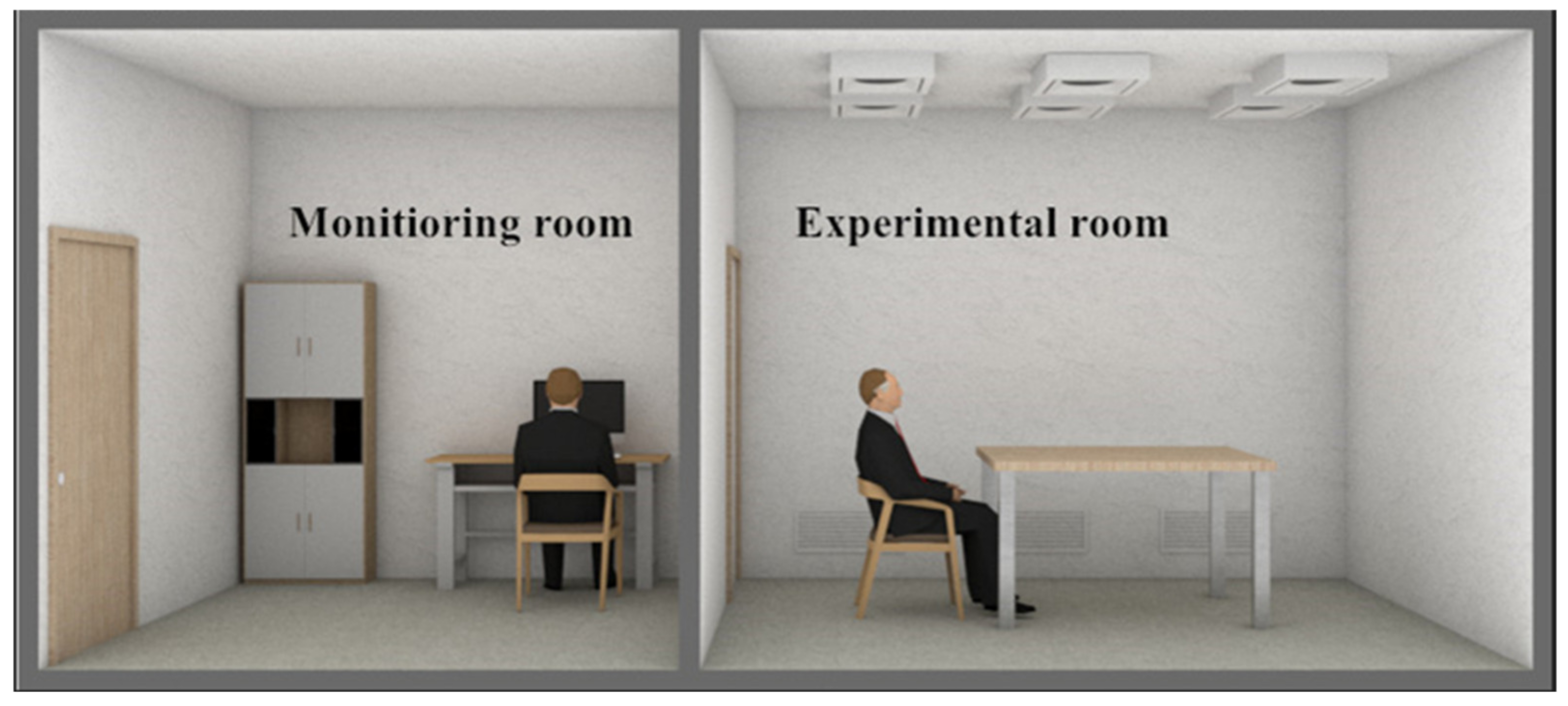
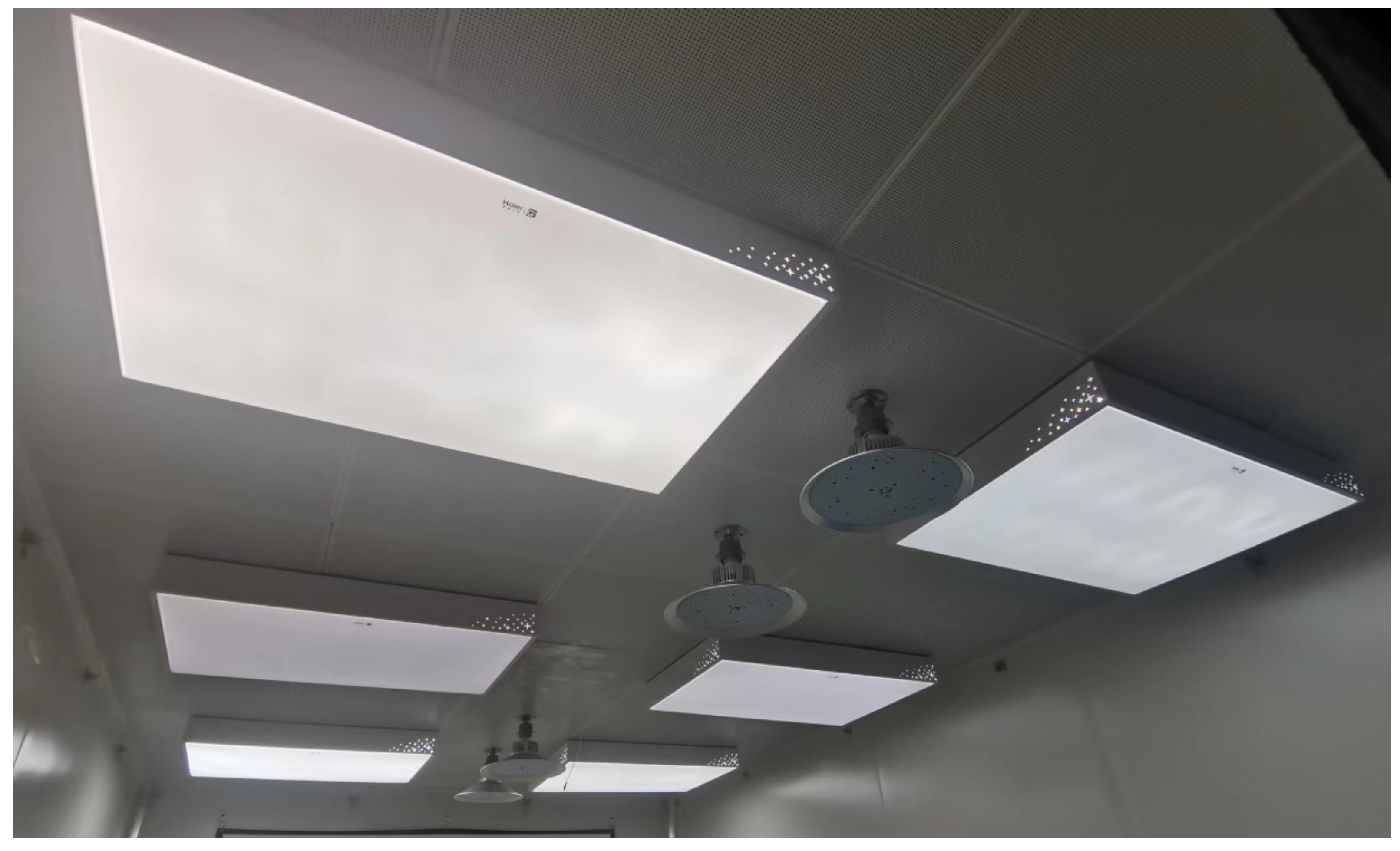
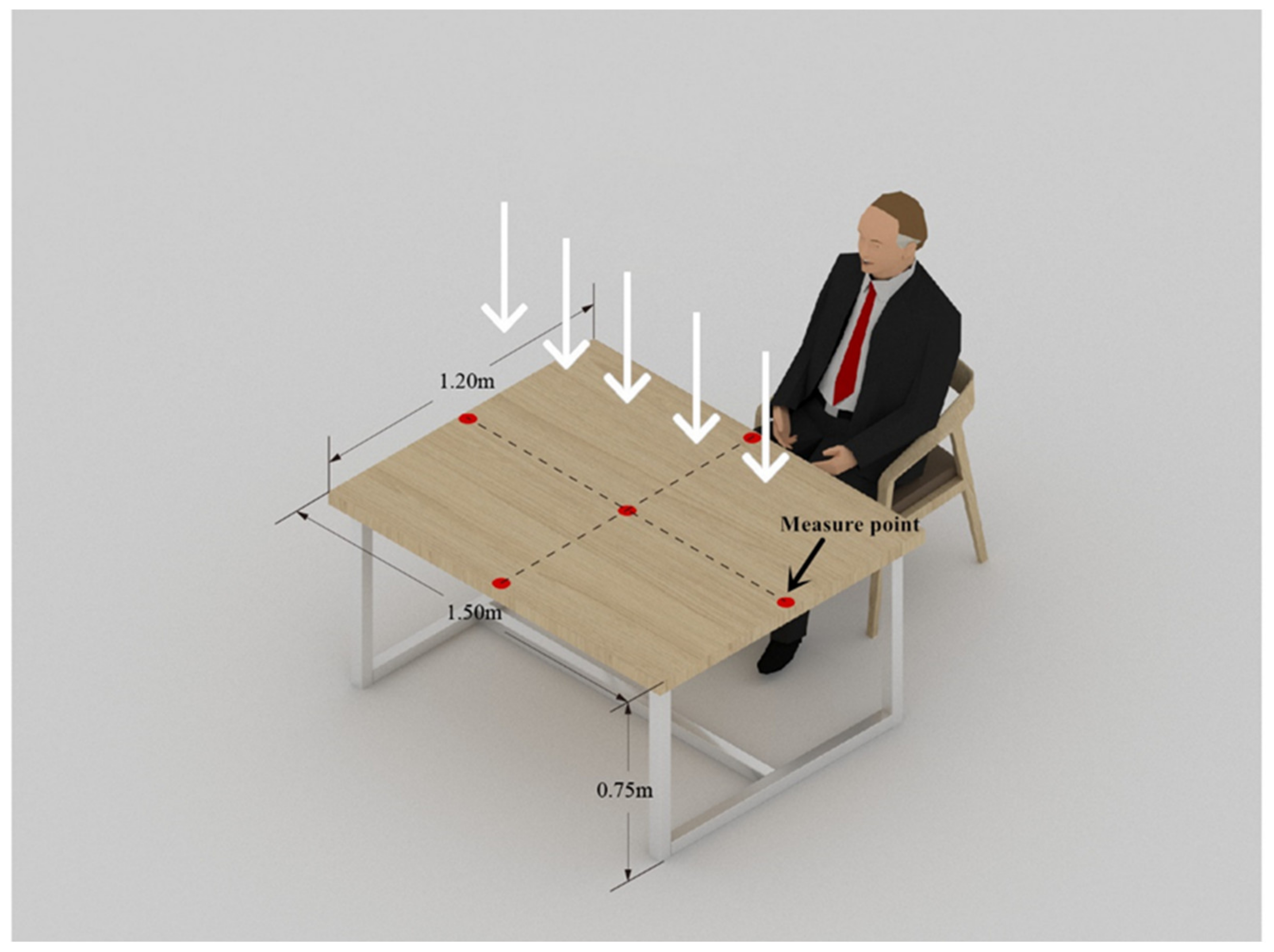

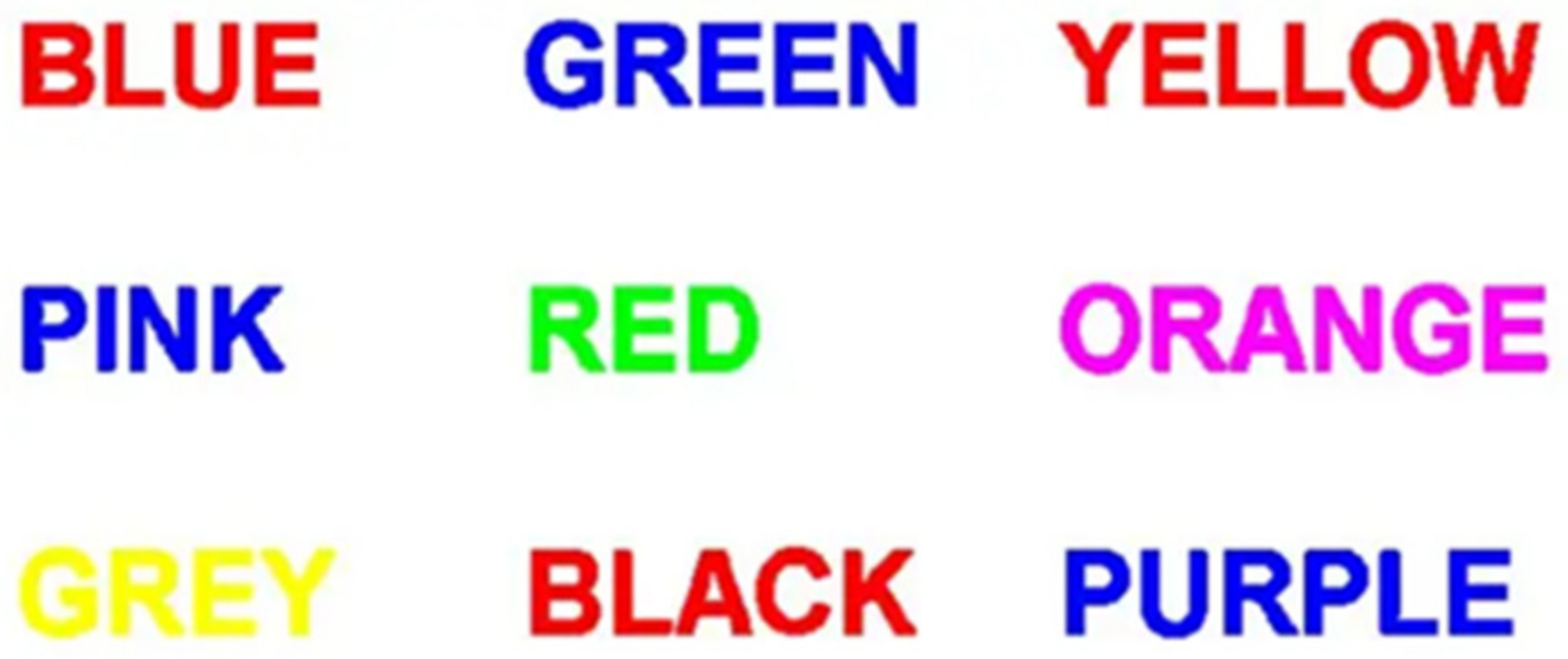
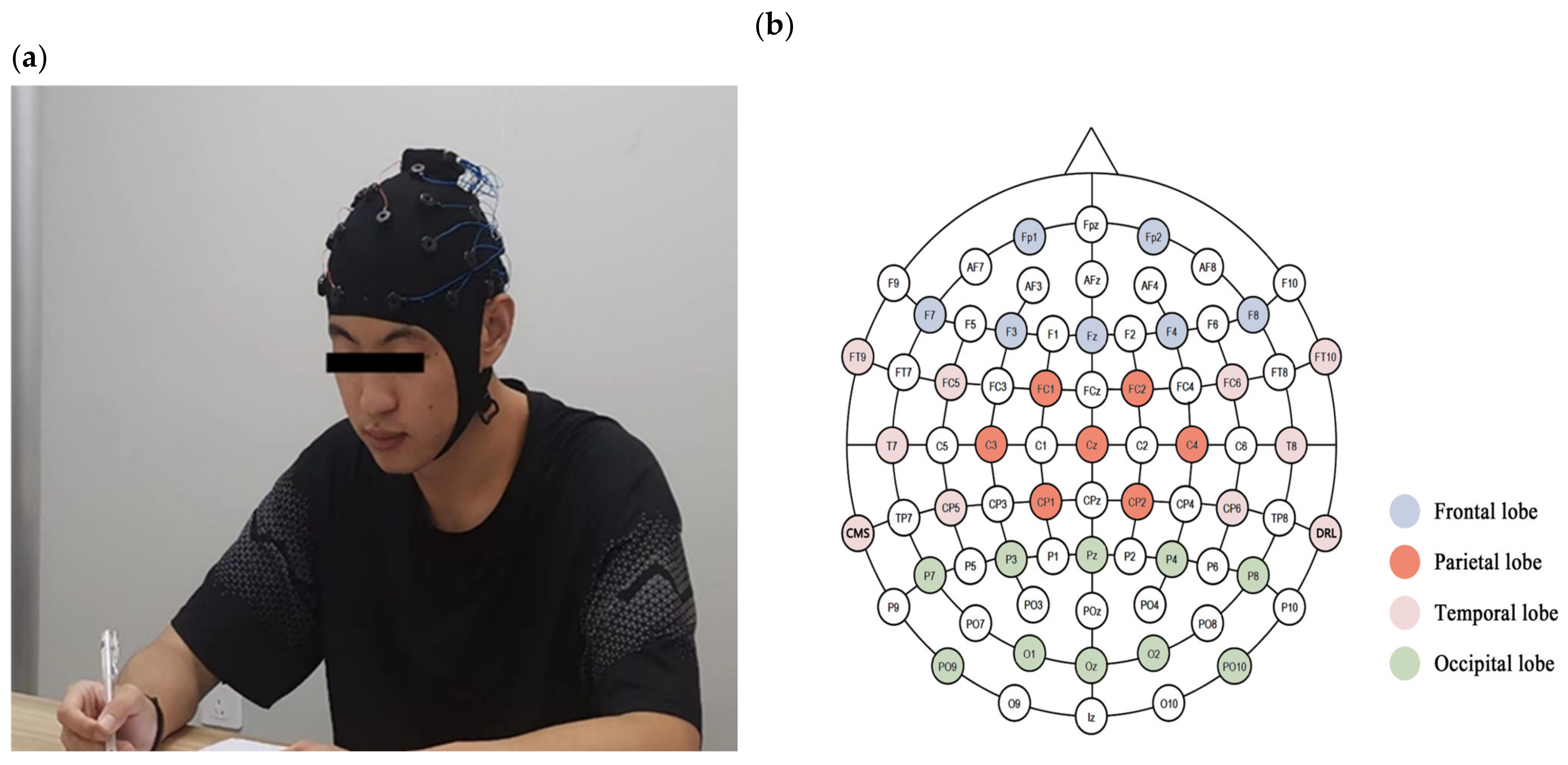
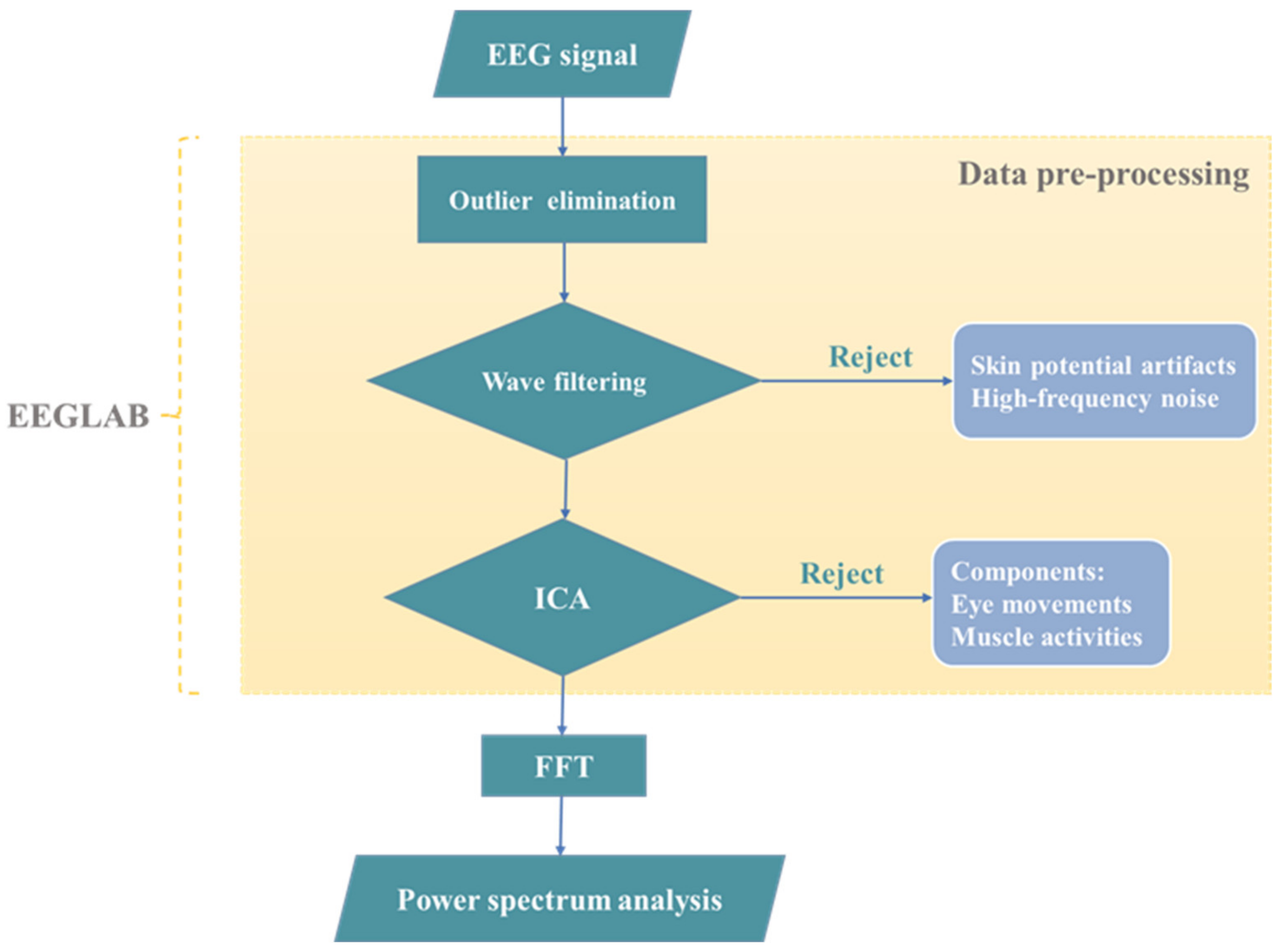
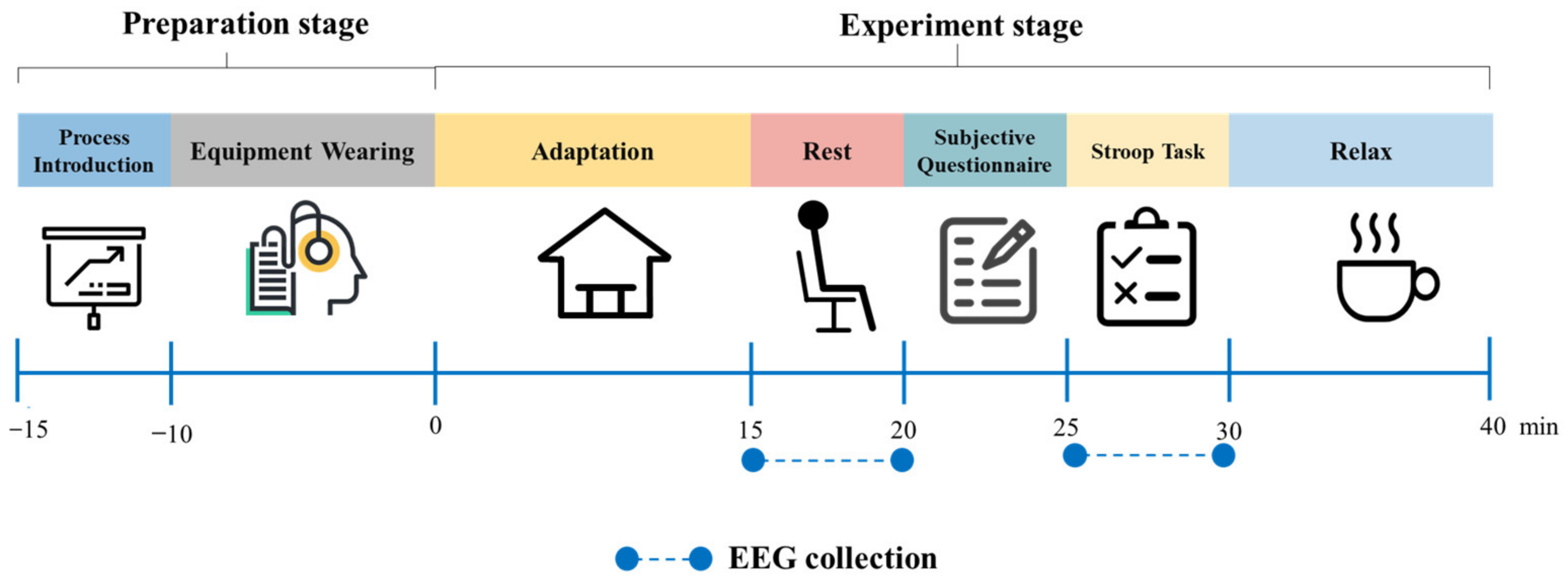
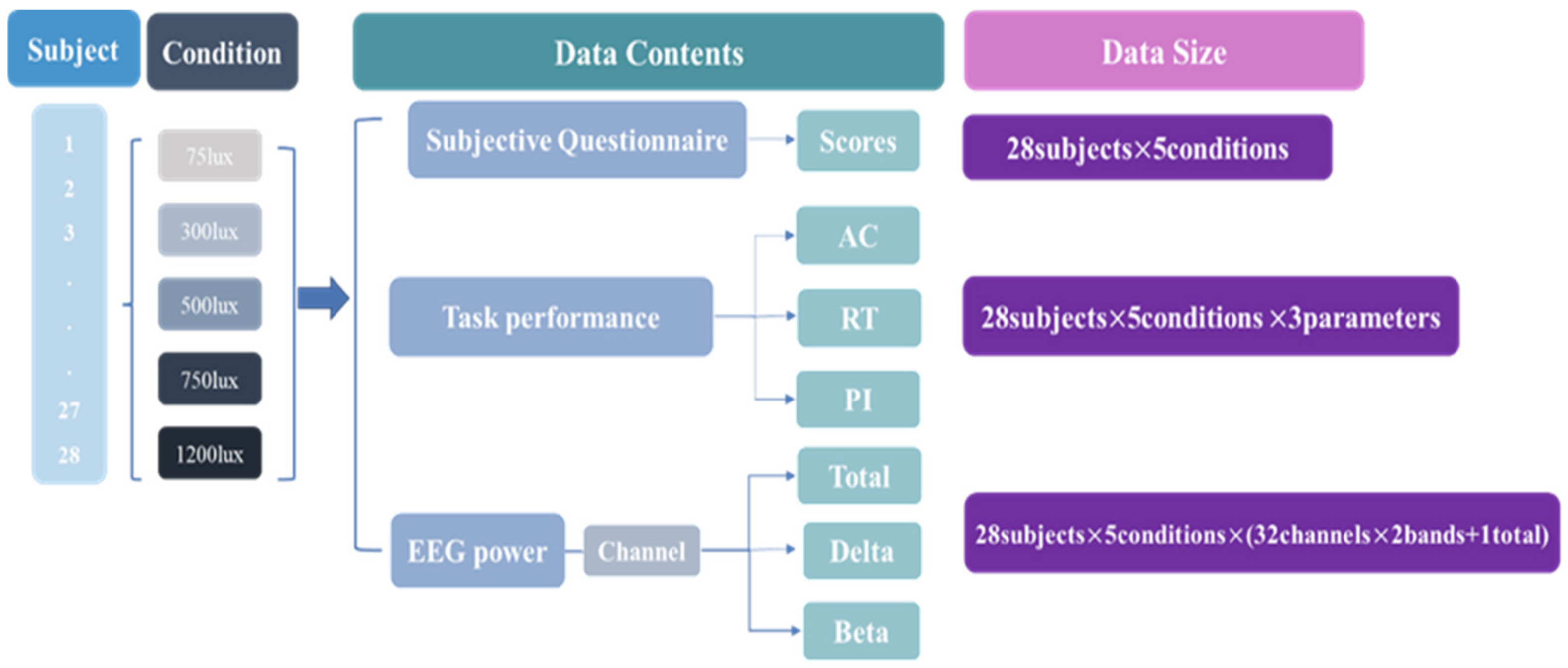
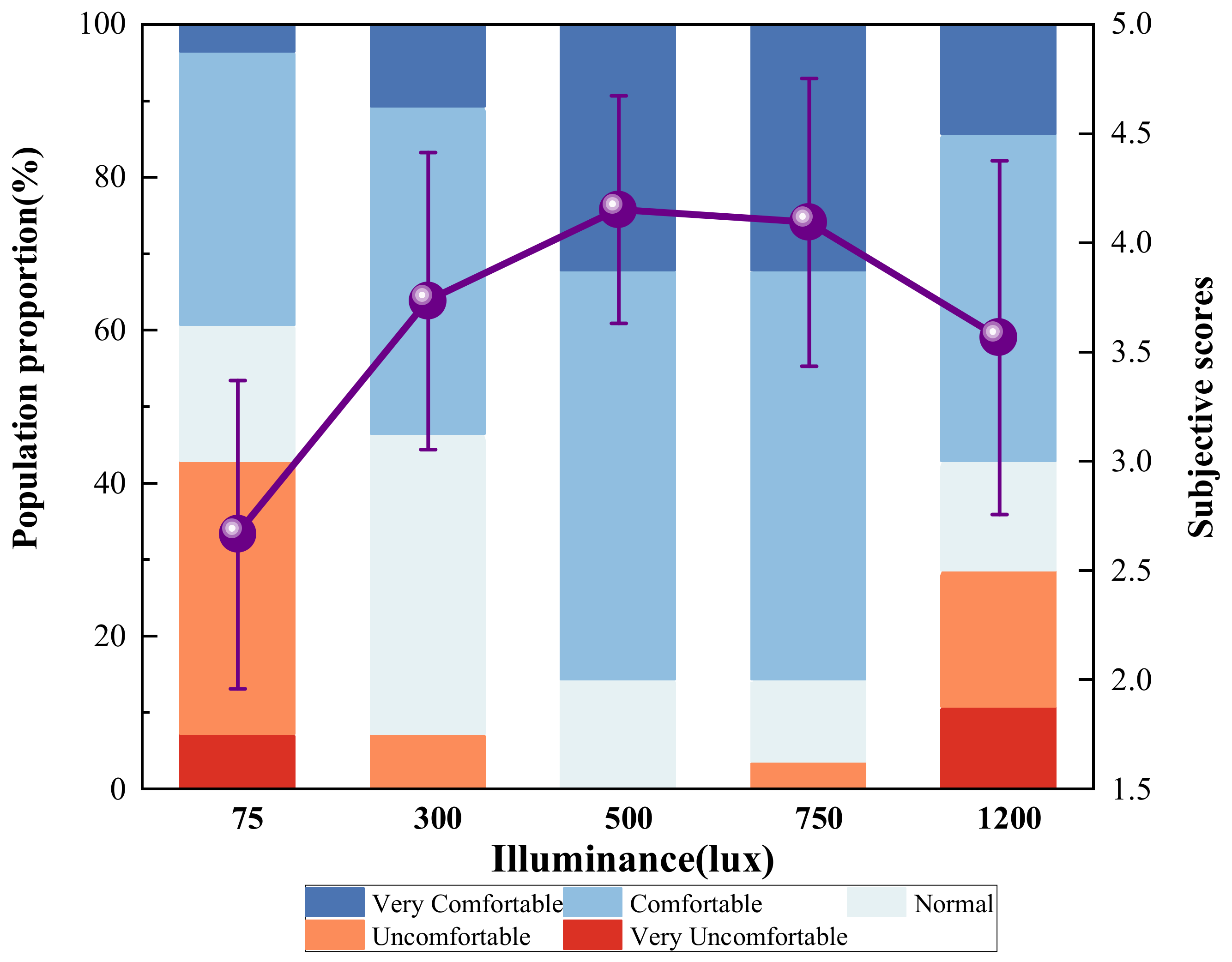
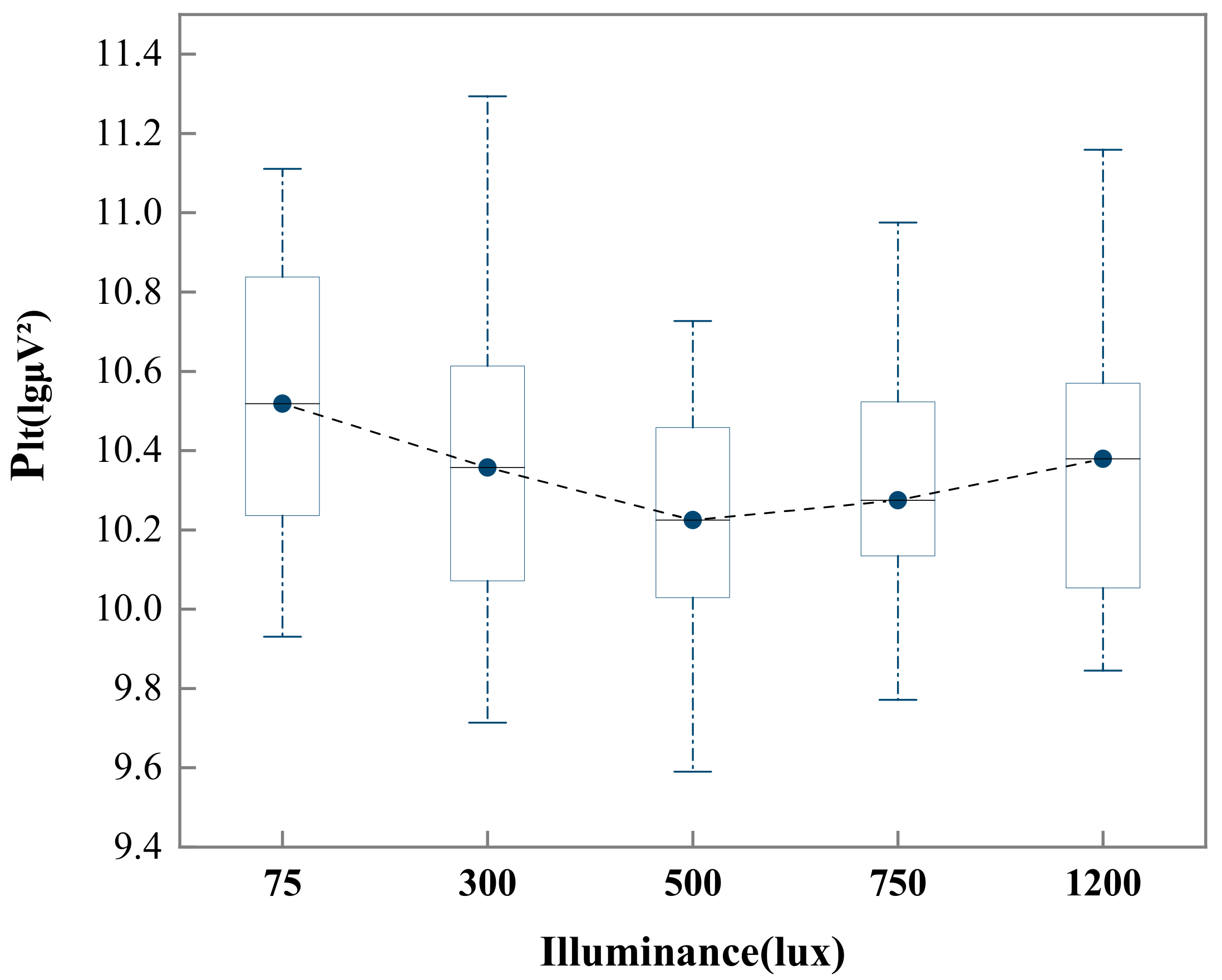
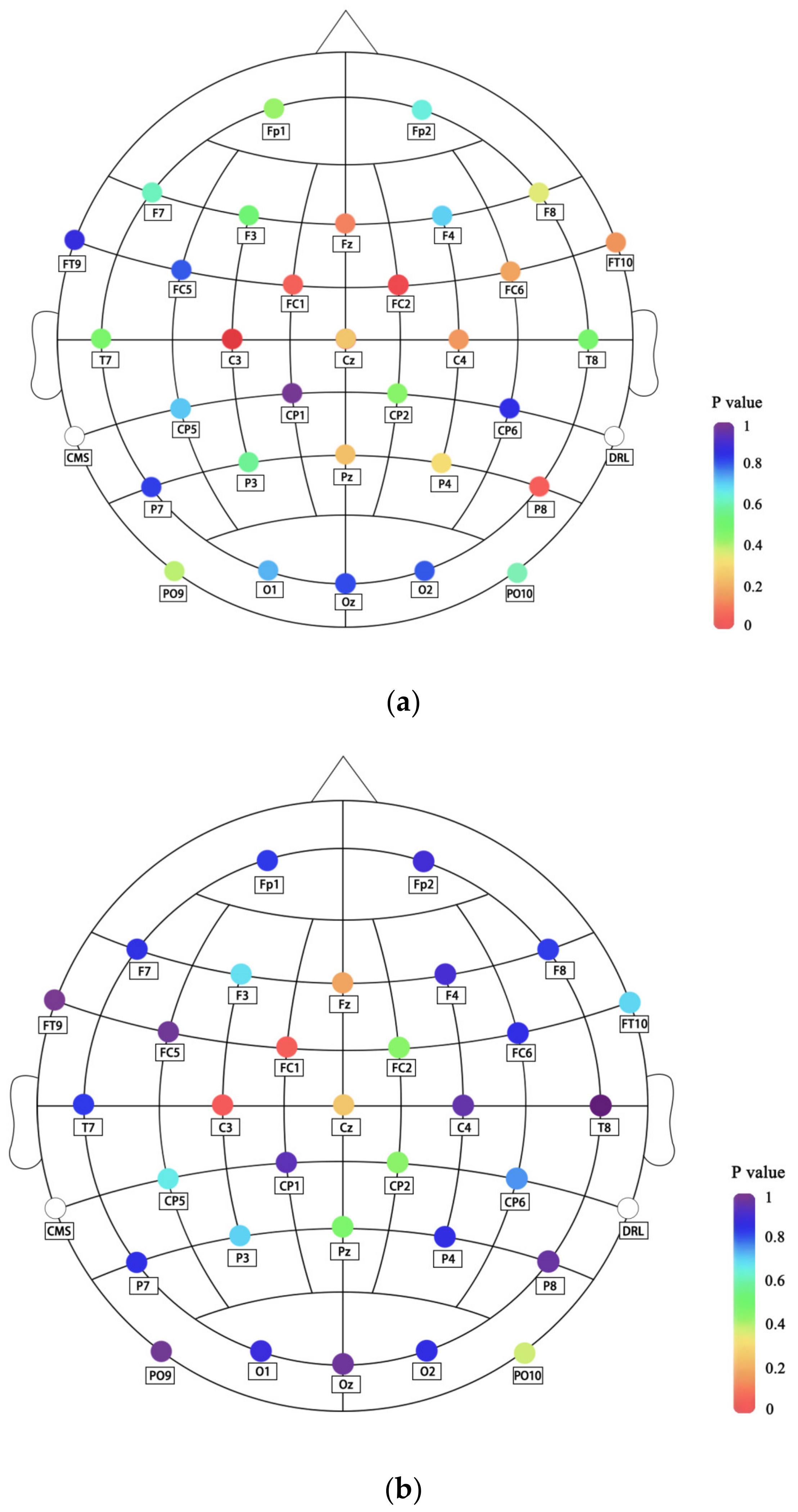
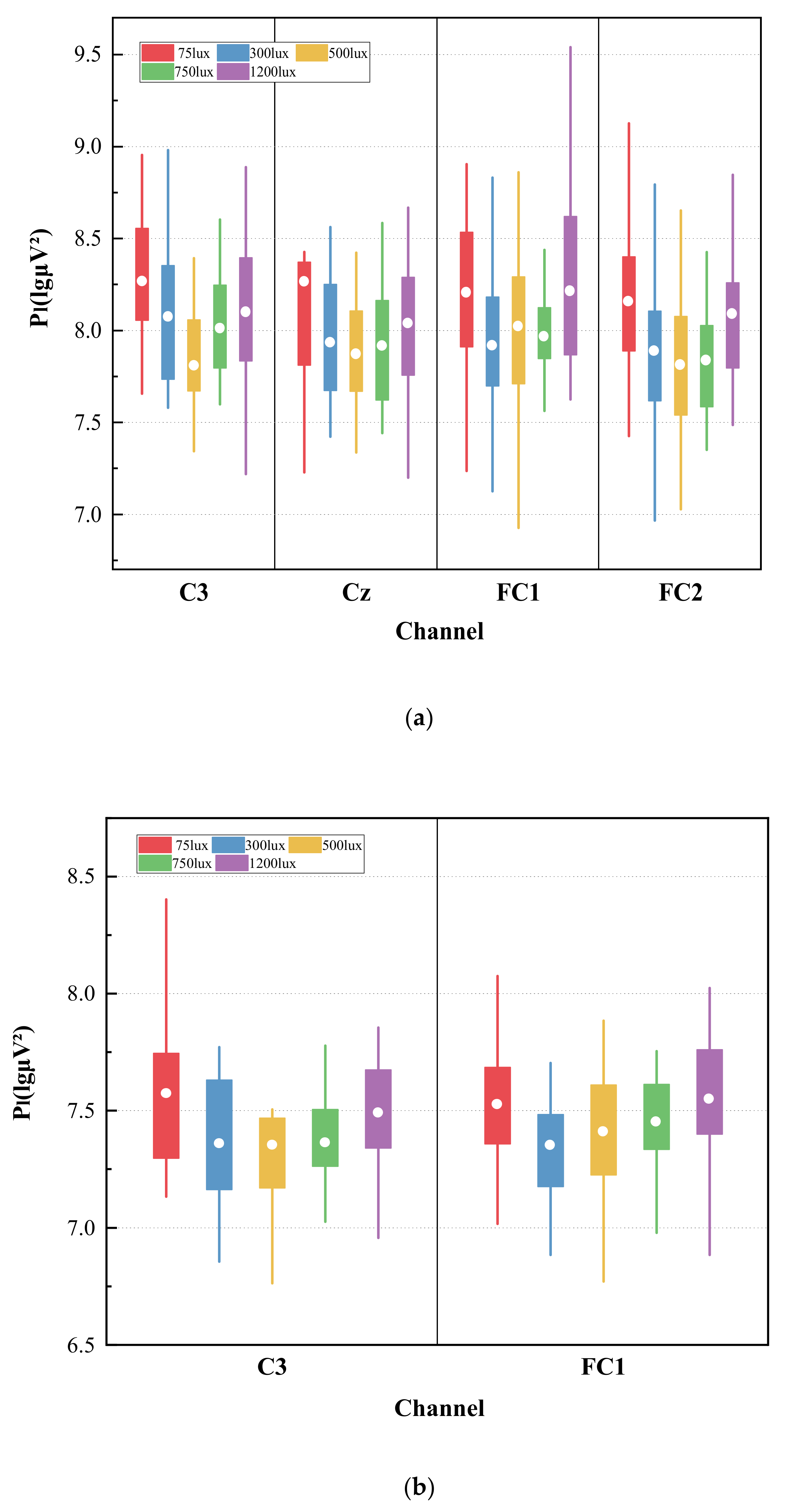
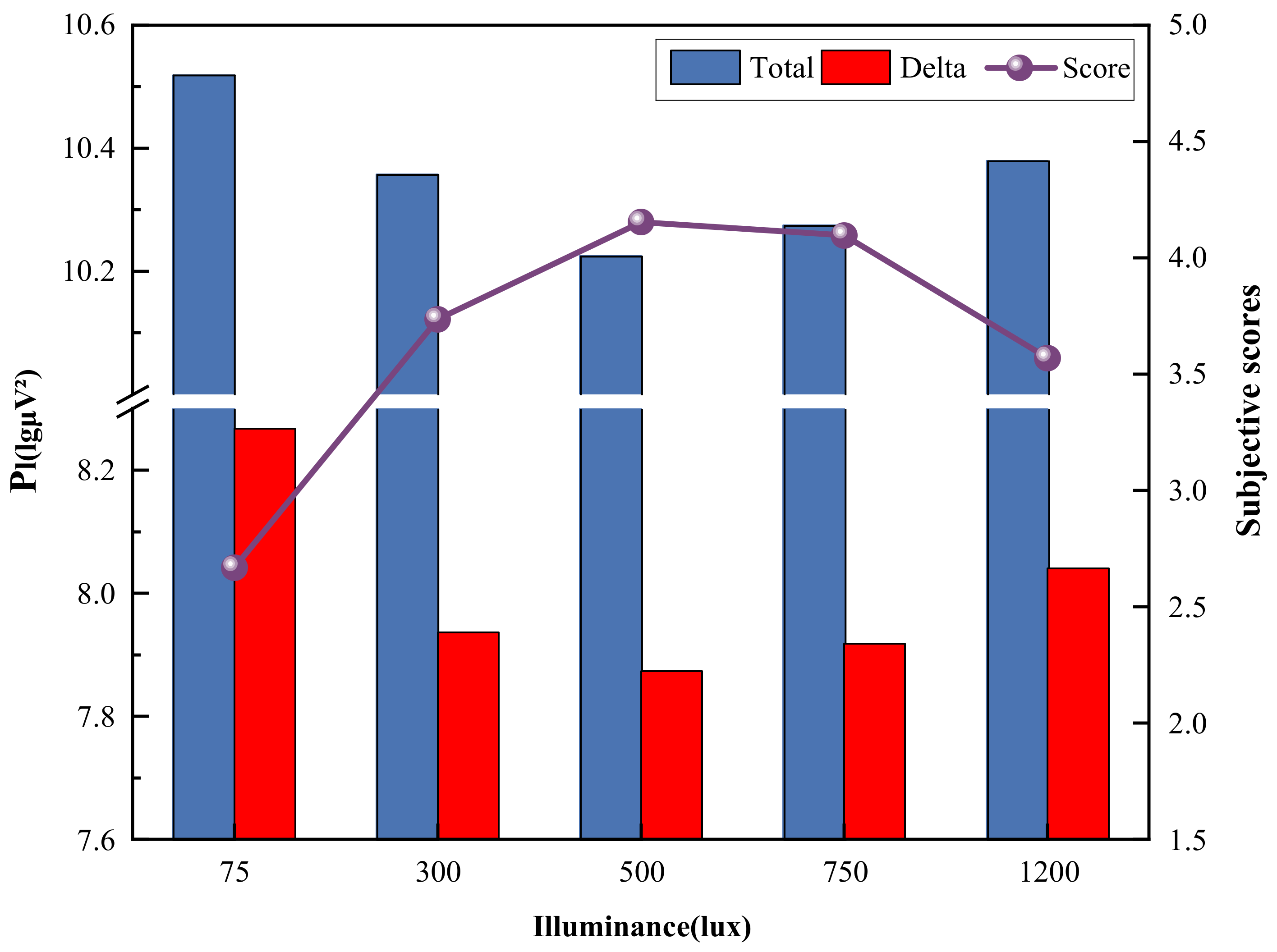
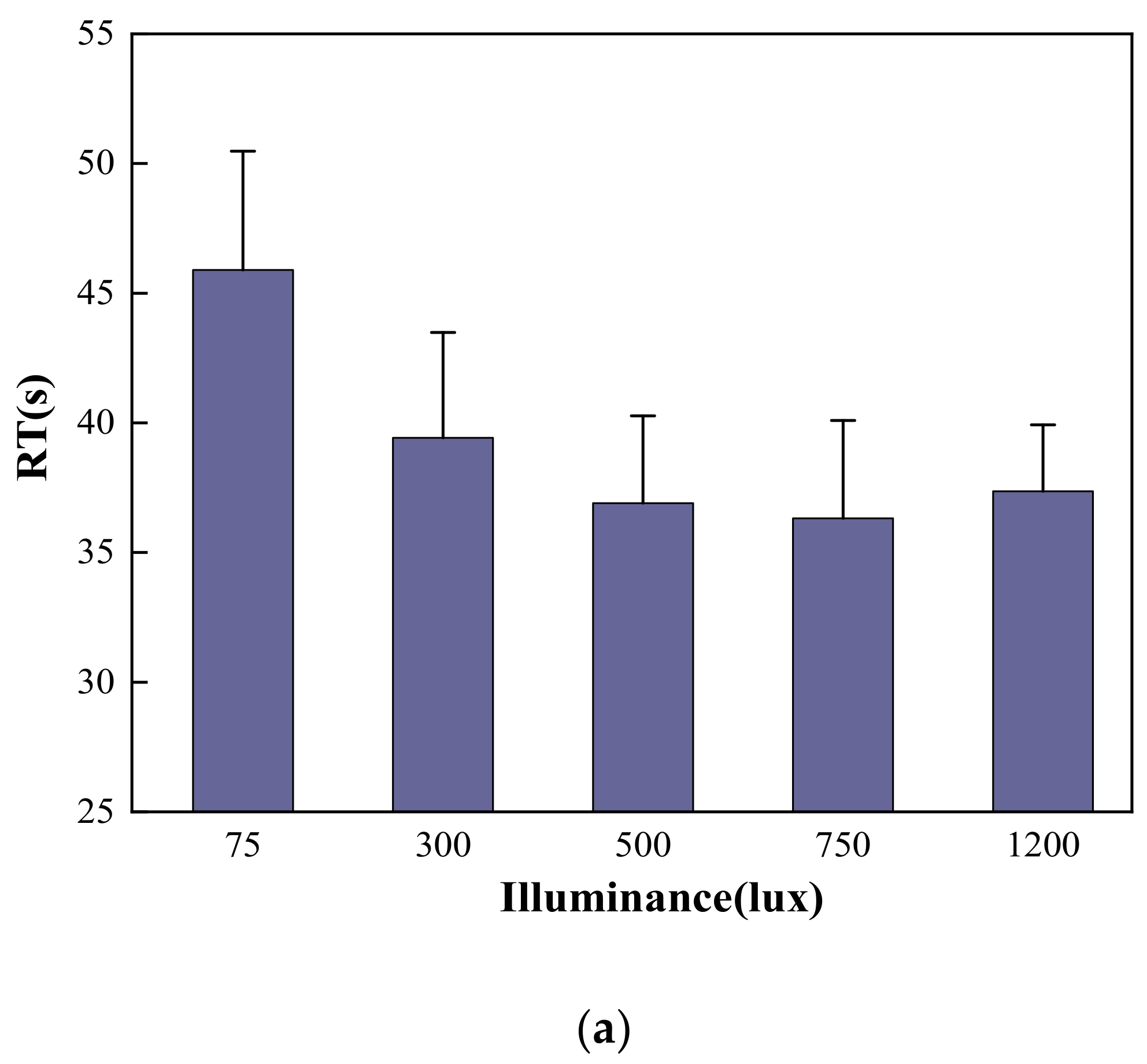
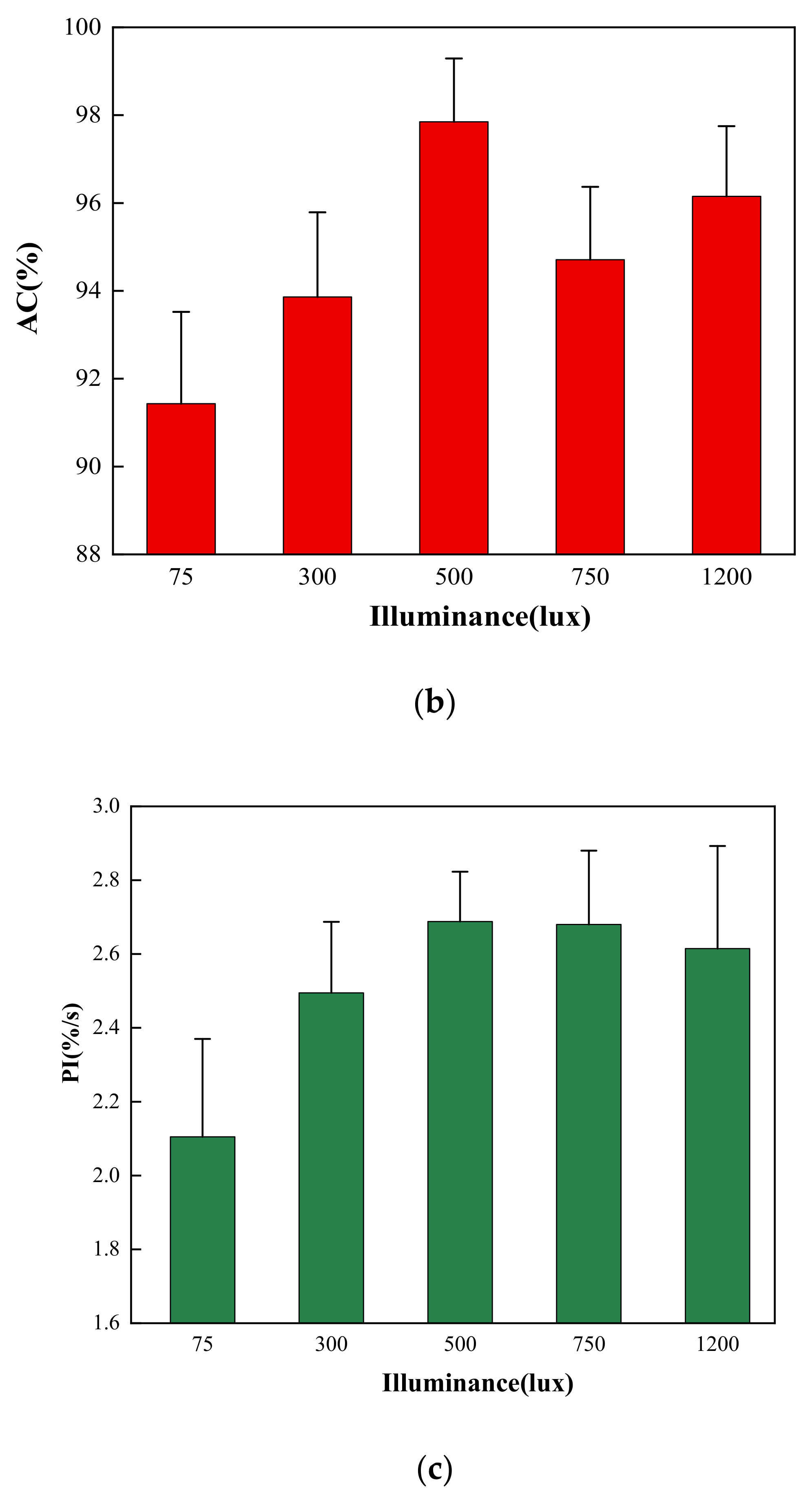
| Parameters | Temperature/°C | Relative Humidity/% | Air Speed/(m/s) | Sound Pressure Level/(dB) |
|---|---|---|---|---|
| Set value | 24 ± 0.5 | 60 ± 5 | 0.05 | <40 |
| Instrument | Type | Detectable Range | Resolution | Physical map |
|---|---|---|---|---|
| Illuminometer | TES-136, China | 0.1 to 99,990 lux 0.1 to 9999 K | ±0.02 lux/±0.02 K |  |
| Temperature and humidity recorder | TR-72U, Japan | −40 to 110 °C 10 to 95%RH | ±0.3 °C/±5% |  |
| Hot-wire anemometer | WFWZY-1, China | 0.05 to 30 m/s | ±(50%Va + 0.05) m/s |  |
| Sound-level meter | TES-1357, China | 30 to 130 dB | ±1.5 dB |  |
| Male | Female | Total | |
|---|---|---|---|
| Age | |||
| Max | 31 | 24 | 31 |
| Min | 22 | 22 | 22 |
| Mean ± SD | 24.09 ± 0.41 | 23.2 ± 0.37 | 23.93 ± 0.35 |
| Vision correction | |||
| Yes | 18 | 3 | 21 |
| No | 5 | 2 | 7 |
| Wave | Frequency/Hz | Body State |
|---|---|---|
| δ | 0.5~4 | Extreme fatigue, deep sleep |
| θ | 4~8 | Blurred consciousness, sleepiness, mute |
| α | 8~13 | Relaxed, calm, eyes closed but awake |
| β | 13~30 | Thinking or processing information |
| Illuminance lux | Order | A | B | C | D | E |
|---|---|---|---|---|---|---|
| Subjects | ||||||
| 1 | 750 | 500 | 1200 | 300 | 75 | |
| 2 | 1200 | 750 | 75 | 500 | 300 | |
| 3 | 75 | 1200 | 300 | 750 | 500 | |
| 4 | 300 | 75 | 500 | 1200 | 750 | |
| 5 | 500 | 300 | 750 | 75 | 1200 | |
| … | … | … | … | … | … | |
| 28 | 300 | 75 | 500 | 1200 | 750 | |
| Illuminance/lux | N | F | p | |
|---|---|---|---|---|
| 75 | 28 | 2.67 ± 0.70 | 18.56 | 0.000 ** |
| 300 | 28 | 3.74 ± 0.68 | ||
| 500 | 28 | 4.15 ± 0.52 | ||
| 750 | 28 | 4.09 ± 0.66 | ||
| 1200 | 28 | 3.57 ± 0.81 |
| Channel | Illuminance/lux | N | F | p | |
|---|---|---|---|---|---|
| C3 | 75 | 28 | 7.58 ± 0.33 | 2.77 | 0.031 * |
| 300 | 28 | 7.36 ± 0.26 | |||
| 500 | 28 | 7.35 ± 0.34 | |||
| 750 | 28 | 7.37 ± 0.25 | |||
| 1200 | 28 | 7.49 ± 0.25 | |||
| FC1 | 75 | 28 | 7.53 ± 0.23 | 3.66 | 0.048 * |
| 300 | 28 | 7.35 ± 0.19 | |||
| 500 | 28 | 7.41 ± 0.31 | |||
| 750 | 28 | 7.45 ± 0.20 | |||
| 1200 | 28 | 7.55 ± 0.28 |
| Channel | Illuminance/lux | N | F | p | |
|---|---|---|---|---|---|
| C3 | 75 | 28 | 8.27 ± 0.32 | 5.28 | 0.001 ** |
| 300 | 28 | 8.08 ± 0.38 | |||
| 500 | 28 | 7.81 ± 0.32 | |||
| 750 | 28 | 8.01 ± 0.29 | |||
| 1200 | 28 | 8.10 ± 0.39 | |||
| Cz | 75 | 28 | 8.27 ± 0.80 | 2.75 | 0.032 * |
| 300 | 28 | 7.94 ± 0.35 | |||
| 500 | 28 | 7.87 ± 0.29 | |||
| 750 | 28 | 7.91 ± 0.31 | |||
| 1200 | 28 | 8.04 ± 0.36 | |||
| FC1 | 75 | 28 | 8.21 ± 0.46 | 2.45 | 0.050 * |
| 300 | 28 | 7.92 ± 0.43 | |||
| 500 | 28 | 8.02 ± 0.42 | |||
| 750 | 28 | 7.97 ± 0.23 | |||
| 1200 | 28 | 8.22 ± 0.51 | |||
| FC2 | 75 | 28 | 8.16 ± 0.38 | 3.66 | 0.008 ** |
| 300 | 28 | 7.89 ± 0.43 | |||
| 500 | 28 | 7.81 ± 0.42 | |||
| 750 | 28 | 7.84 ± 0.30 | |||
| 1200 | 28 | 8.09 ± 0.39 |
| Statistics | ||||||||
|---|---|---|---|---|---|---|---|---|
| C3 | Cz | FC1 | FC2 | C3 | FC1 | |||
| Light comfort | Correlation coefficient | −0.892 | −0.983 | −0.697 | −0.908 | −0.927 | −0.566 | −0.980 |
| Significance | 0.042 * | 0.003 ** | 0.191 | 0.033 * | 0.024 * | 0.320 | 0.003 ** | |
| Statistics | Illuminance/lux | N | F | p | |
|---|---|---|---|---|---|
| Reaction Time (s) | 75 | 28 | 45.90 ± 8.58 | 7.73 | 0.000 ** |
| 300 | 28 | 39.78 ± 8.06 | |||
| 500 | 28 | 36.91 ± 6.37 | |||
| 750 | 28 | 36.31 ± 5.78 | |||
| 1200 | 28 | 37.36 ± 5.56 | |||
| Accuracy (%) | 75 | 28 | 91.43 ± 6.09 | 3.80 | 0.006 ** |
| 300 | 28 | 93.86 ± 6.93 | |||
| 500 | 28 | 97.85 ± 3.43 | |||
| 750 | 28 | 94.71 ± 5.66 | |||
| 1200 | 28 | 96.15 ± 5.60 | |||
| 75 | 28 | 2.10 ± 0.57 | 6.22 | 0.000 ** | |
| 300 | 28 | 2.49 ± 0.49 | |||
| Performance Indicators (%/s) | 500 | 28 | 2.68 ± 0.53 | ||
| 750 | 28 | 2.68 ± 0.50 | |||
| 1200 | 28 | 2.61 ± 0.48 |
| Illuminance/lux | N | F | p | |
|---|---|---|---|---|
| 75 | 28 | 9.89 ± 0.36 | 0.518 | 0.722 |
| 300 | 28 | 9.95 ± 0.37 | ||
| 500 | 28 | 9.91 ± 0.35 | ||
| 750 | 28 | 9.90 ± 0.29 | ||
| 1200 | 28 | 10.02 ± 0.35 |
Disclaimer/Publisher’s Note: The statements, opinions and data contained in all publications are solely those of the individual author(s) and contributor(s) and not of MDPI and/or the editor(s). MDPI and/or the editor(s) disclaim responsibility for any injury to people or property resulting from any ideas, methods, instructions or products referred to in the content. |
© 2023 by the authors. Licensee MDPI, Basel, Switzerland. This article is an open access article distributed under the terms and conditions of the Creative Commons Attribution (CC BY) license (https://creativecommons.org/licenses/by/4.0/).
Share and Cite
Tong, L.; Liu, N.; Hu, S.; Lu, M.; Zheng, Y.; Ma, X. Research on the Preferred Illuminance in Office Environments Based on EEG. Buildings 2023, 13, 467. https://doi.org/10.3390/buildings13020467
Tong L, Liu N, Hu S, Lu M, Zheng Y, Ma X. Research on the Preferred Illuminance in Office Environments Based on EEG. Buildings. 2023; 13(2):467. https://doi.org/10.3390/buildings13020467
Chicago/Turabian StyleTong, Li, Nian Liu, Songtao Hu, Mingli Lu, Yuxi Zheng, and Xiaohui Ma. 2023. "Research on the Preferred Illuminance in Office Environments Based on EEG" Buildings 13, no. 2: 467. https://doi.org/10.3390/buildings13020467
APA StyleTong, L., Liu, N., Hu, S., Lu, M., Zheng, Y., & Ma, X. (2023). Research on the Preferred Illuminance in Office Environments Based on EEG. Buildings, 13(2), 467. https://doi.org/10.3390/buildings13020467





